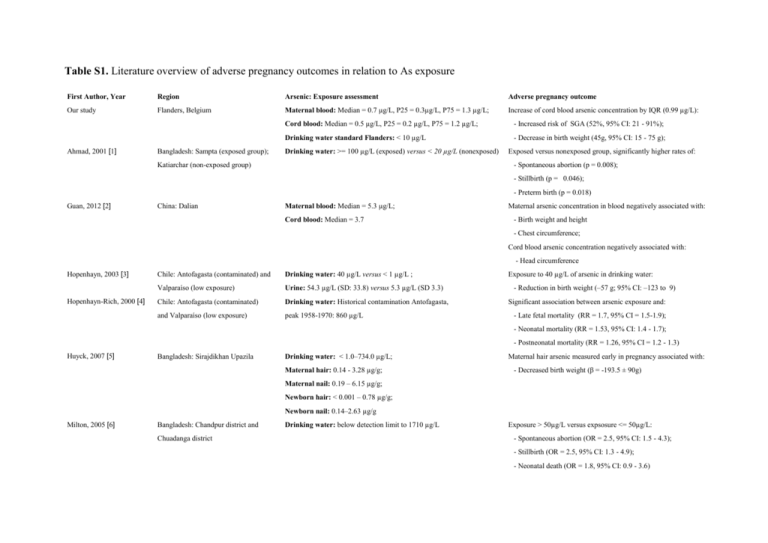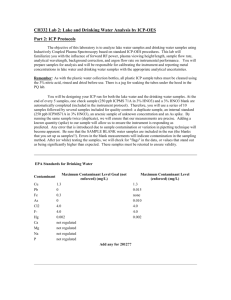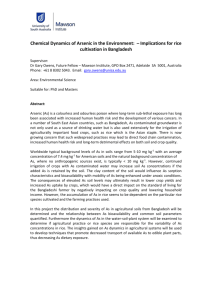Table S1. Literature overview of adverse pregnancy
advertisement

Table S1. Literature overview of adverse pregnancy outcomes in relation to As exposure First Author, Year Region Arsenic: Exposure assessment Adverse pregnancy outcome Our study Flanders, Belgium Maternal blood: Median = 0.7 µg/L, P25 = 0.3µg/L, P75 = 1.3 µg/L; Increase of cord blood arsenic concentration by IQR (0.99 µg/L): Ahmad, 2001 [1] Bangladesh: Sampta (exposed group); Cord blood: Median = 0.5 µg/L, P25 = 0.2 µg/L, P75 = 1.2 µg/L; - Increased risk of SGA (52%, 95% CI: 21 - 91%); Drinking water standard Flanders: < 10 µg/L - Decrease in birth weight (45g, 95% CI: 15 - 75 g); Drinking water: >= 100 µg/L (exposed) versus < 20 µg/L (nonexposed) Katiarchar (non-exposed group) Exposed versus nonexposed group, significantly higher rates of: - Spontaneous abortion (p = 0.008); - Stillbirth (p = 0.046); - Preterm birth (p = 0.018) Guan, 2012 [2] China: Dalian Maternal blood: Median = 5.3 µg/L; Cord blood: Median = 3.7 Maternal arsenic concentration in blood negatively associated with: - Birth weight and height - Chest circumference; Cord blood arsenic concentration negatively associated with: - Head circumference Hopenhayn, 2003 [3] Hopenhayn-Rich, 2000 [4] Chile: Antofagasta (contaminated) and Drinking water: 40 µg/L versus < 1 µg/L ; Valparaíso (low exposure) Urine: 54.3 µg/L (SD: 33.8) versus 5.3 µg/L (SD 3.3) Chile: Antofagasta (contaminated) Drinking water: Historical contamination Antofagasta, and Valparaíso (low exposure) peak 1958-1970: 860 µg/L Exposure to 40 µg/L of arsenic in drinking water: - Reduction in birth weight (–57 g; 95% CI: –123 to 9) Significant association between arsenic exposure and: - Late fetal mortality (RR = 1.7, 95% CI = 1.5-1.9); - Neonatal mortality (RR = 1.53, 95% CI: 1.4 - 1.7); - Postneonatal mortality (RR = 1.26, 95% CI = 1.2 - 1.3) Huyck, 2007 [5] Bangladesh: Sirajdikhan Upazila Drinking water: < 1.0–734.0 µg/L; Maternal hair: 0.14 - 3.28 µg/g; Maternal hair arsenic measured early in pregnancy associated with: - Decreased birth weight (β = -193.5 ± 90g) Maternal nail: 0.19 – 6.15 µg/g; Newborn hair: < 0.001 – 0.78 µg/g; Newborn nail: 0.14–2.63 µg/g Milton, 2005 [6] Bangladesh: Chandpur district and Chuadanga district Drinking water: below detection limit to 1710 µg/L Exposure > 50µg/L versus expsosure <= 50µg/L: - Spontaneous abortion (OR = 2.5, 95% CI: 1.5 - 4.3); - Stillbirth (OR = 2.5, 95% CI: 1.3 - 4.9); - Neonatal death (OR = 1.8, 95% CI: 0.9 - 3.6) Rahman, 2007 [7] Bangladesh: Matlab Drinking water: Mean: 239 µg/L; Median: 224 µg/L; P10 < 1 µg/L; P90: 513 µg/L Exposure > 50µg/L: - Fetal Loss (Relative Risk = 1.14, 95% CI: 1.04 - 1.25); - Infant death (Relative Risk: 1.17, 95% CI: 1.03 - 1.32) Rahman, 2009 [8] Bangladesh: Matlab Urine: Median = 95 µg/L, P10 = 26 µg/L, P90 = 444 µg/L Lower exposure level (0 - 100µg/L), increase of 1µg/L associated to: - Reduction in birth weight with 1.68 g; - Reduction in head circumference with 0.05 mm; - Reduction in chest circumference with 0.14 mm. With higher exposure level (> 100µg/L), no additional effect was observed. Rahman, 2010 [9] Bangladesh: Matlab Urine: Median: 382 μg/L; P20: < 33 µg/L; P80: 249 -1253 µg/L Exposure P80 versus P20: Rahman, 2010 [9] Bangladesh: Matlab Urine: Median: 390 μg/L; P20: < 38 µg/L; P80: 268-2019 µg/L Exposure P80 versus P20: - Spontaneous abortion: OR = 1.4, 95% CI: 0.96 - 2.2; - Infant mortality: Hazard ratio = 5.0, CI: 1.4 - 1.8 von Ehrenstein, 2006 [10] West Bengal, India Drinking water: Categorical: 0-49 µg/L; 50-199 µg/L; >= 200 µg/L Exposure to >= 200 µg/L: - Increased risk of stillbirth (OR = 6.07, 95% CI: 1.54 to 24.0); - Increased risk of neonatal death (OR = 2.81, 95% CI: 0.73 - 10.8) Xu, 2011 [11] China: Shangai Maternal blood: Mean = 4,13 µg/L; Cord blood: Mean = 3,82 µg/L Maternal arsenic concentration in blood negatively associated to: - Birth weight; - Gestational age Yang, 2003 [12] Taiwan: 4 townships in the northeast Drinking water: Exposed group: Up to 3590 µg/L, (exposed group) versus 4 townships highest median concentration of 4 townships = 140 µg/L; with no historic evidence of arsenic Control group: < 0,9 µg/L Exposed versus control group: - Reduction in birth weigth (25.09 g, 95%CI: 13.55 - 44.55) water contamination (control group) Abbreviations: CI: Confidence interval; OR = Odds ratio; P10 = 10 th percentile; P25 = 25th percentile; P75 = 75th percentile; P90 = 90th percentile; SGA: small for gestational age Reference List: 1. Ahmad SA, Sayed MH, Barua S, Khan MH, Faruquee MH, et al. (2001) Arsenic in drinking water and pregnancy outcomes. Environ Health Perspect 109: 629-631. 2. Guan H, Piao F, Zhang X, Li X, Li Q, et al. (2012) Prenatal exposure to arsenic and its effects on fetal development in the general population of Dalian. Biol Trace Elem Res 149: 10-15. 3. Hopenhayn C, Ferreccio C, Browning SR, Huang B, Peralta C, Gibb H, Hertz-Picciotto I (2003) Arsenic exposure from drinking water and birth weight. Epidemiology 14: 593-602. 4. Hopenhayn-Rich C, Browning SR, Hertz-Picciotto I, Ferreccio C, Peralta C, et al. (2000) Chronic arsenic exposure and risk of infant mortality in two areas of Chile. Environ Health Perspect 108: 667-673. 5. Huyck KL, Kile ML, Mahiuddin G, Quamruzzaman Q, Rahman M, et al. (2007) Maternal arsenic exposure associated with low birth weight in Bangladesh. J Occup Environ Med 49: 1097-1104. 6. Milton AH, Smith W, Rahman B, Hasan Z, Kulsum U, et al. (2005) Chronic arsenic exposure and adverse pregnancy outcomes in bangladesh. Epidemiology 16: 82-86. 7. Rahman A, Vahter M, Ekstrom EC, Rahman M, Golam Mustafa AH, et al. (2007) Association of arsenic exposure during pregnancy with fetal loss and infant death: a cohort study in Bangladesh. Am J Epidemiol 165: 1389-1396. 8. Rahman A, Vahter M, Smith AH, Nermell B, Yunus M, et al. (2009) Arsenic exposure during pregnancy and size at birth: a prospective cohort study in Bangladesh. Am J Epidemiol 169: 304-312. 9. Rahman A, Persson LA, Nermell B, El AS, Ekstrom EC, et al. (2010) Arsenic exposure and risk of spontaneous abortion, stillbirth, and infant mortality. Epidemiology 21: 797-804. 10. von Ehrenstein OS, Guha Mazumder DN, Hira-Smith M, Ghosh N, Yuan Y et al. (2006) Pregnancy outcomes, infant mortality, and arsenic in drinking water in West Bengal, India. Am J Epidemiol 163: 662-669. 11. Xu L, Yokoyama K, Tian Y, Piao FY, Kitamura F, et al. (2011) Decrease in birth weight and gestational age by arsenic among the newborn in Shanghai, China. Nihon Koshu Eisei Zasshi 58: 89-95. 12. Yang CY, Chang CC, Tsai SS, Chuang HY, Ho CK, et al. (2003) Arsenic in drinking water and adverse pregnancy outcome in an arseniasis-endemic area in northeastern Taiwan. Environ Res 91: 29-34.








